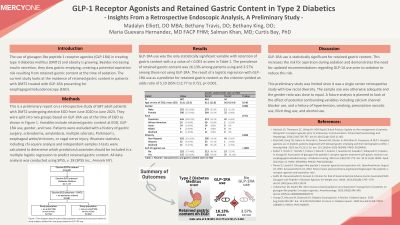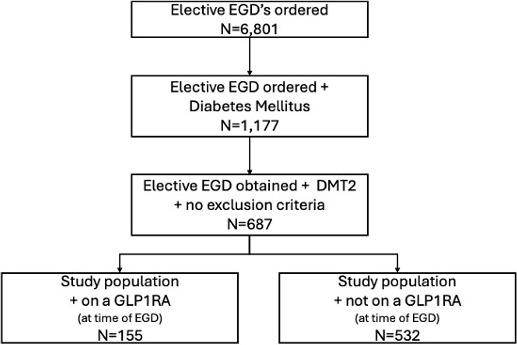Monday Poster Session
Category: General Endoscopy
P2392 - GLP-1 Receptor Agonists and Retained Gastric Content in Type 2 Diabetics: Insights From a Retrospective Endoscopic Analysis, A Preliminary Study
Monday, October 28, 2024
10:30 AM - 4:00 PM ET
Location: Exhibit Hall E

Has Audio

Madalyn Elliott, DO, MBA
MercyOne Des Moines
Des Moines, IA
Presenting Author(s)
Madalyn Elliott, DO, MBA1, Bethany Travis, DO1, Bethany King, DO1, Maria Guevara Hernandez, MD1, Salman Khan, MD2, Curt Bay, PhD3
1MercyOne Des Moines, Des Moines, IA; 2MercyOne, Des Moines, IA; 3A.T. Still University School of Osteopathic Medicine, Mesa, AZ
Introduction: The use of glucagon-like peptide 1 receptor agonists (GLP-1RA) in treating type II diabetes mellitus (DMT2) and obesity is growing. Besides increasing insulin secretion, they slow gastric emptying, creating a potential aspiration risk resulting from retained gastric content at the time of sedation. The current study looks at the incidence of retained gastric content in patients with DMT2 treated with GLP-1RA presenting for esophagogastroduodenoscopy (EGD).
Methods: This is a preliminary report on a retrospective study of 687 adult patients with DMT2 undergoing elective EGD from June 2020 to June 2023. They were split into two groups based on GLP-1RA use at the time of EGD as shown in Figure 1. Variables include retained gastric content at EGD, GLP-1RA use, gender, and race. Patients were excluded with a history of gastric surgery, scleroderma, amyloidosis, multiple sclerosis, Parkinson’s, esophageal webs/strictures, or vagal nerve injury. Bivariate statistics, including chi-square analysis and independent-samples t-tests were calculated to determine which predictors/covariates should be included in a multiple logistic regression to predict retained gastric content. All data analysis was conducted using SPSS, v. 28 (SPSS Inc., Armonk NY).
Results: GLP-1RA use was the only statistically significant variable with retention of gastric content with a p value of < 0.001 as seen in Table 1. The prevalence of retained gastric content was 16.13% among patients using and 3.57% among those not using GLP-1RA. The result of a logistic regression with GLP-1RA use as a predictor for retained gastric content as the criterion yielded an odds ratio of 5.19 (95% CI:2.77 to 9.72), p< 0.001.
Discussion: GLP-1RA use is statistically significant for retained gastric content. This increases the risk for aspiration during sedation and demonstrates the need for updated recommendations regarding GLP-1A use prior to sedation to reduce this risk.
This preliminary study was limited since it was a single center retrospective study with low racial diversity. The sample size was otherwise adequate and the gender ratio was close to equal. A future analysis is planned to look at the effect of potential confounding variables including calcium channel blocker use, and a history of hypertension, smoking, prescription narcotic use, illicit drug use, and alcohol use.

Note: The table for this abstract can be viewed in the ePoster Gallery section of the ACG 2024 ePoster Site or in The American Journal of Gastroenterology's abstract supplement issue, both of which will be available starting October 27, 2024.
Disclosures:
Madalyn Elliott, DO, MBA1, Bethany Travis, DO1, Bethany King, DO1, Maria Guevara Hernandez, MD1, Salman Khan, MD2, Curt Bay, PhD3. P2392 - GLP-1 Receptor Agonists and Retained Gastric Content in Type 2 Diabetics: Insights From a Retrospective Endoscopic Analysis, A Preliminary Study, ACG 2024 Annual Scientific Meeting Abstracts. Philadelphia, PA: American College of Gastroenterology.
1MercyOne Des Moines, Des Moines, IA; 2MercyOne, Des Moines, IA; 3A.T. Still University School of Osteopathic Medicine, Mesa, AZ
Introduction: The use of glucagon-like peptide 1 receptor agonists (GLP-1RA) in treating type II diabetes mellitus (DMT2) and obesity is growing. Besides increasing insulin secretion, they slow gastric emptying, creating a potential aspiration risk resulting from retained gastric content at the time of sedation. The current study looks at the incidence of retained gastric content in patients with DMT2 treated with GLP-1RA presenting for esophagogastroduodenoscopy (EGD).
Methods: This is a preliminary report on a retrospective study of 687 adult patients with DMT2 undergoing elective EGD from June 2020 to June 2023. They were split into two groups based on GLP-1RA use at the time of EGD as shown in Figure 1. Variables include retained gastric content at EGD, GLP-1RA use, gender, and race. Patients were excluded with a history of gastric surgery, scleroderma, amyloidosis, multiple sclerosis, Parkinson’s, esophageal webs/strictures, or vagal nerve injury. Bivariate statistics, including chi-square analysis and independent-samples t-tests were calculated to determine which predictors/covariates should be included in a multiple logistic regression to predict retained gastric content. All data analysis was conducted using SPSS, v. 28 (SPSS Inc., Armonk NY).
Results: GLP-1RA use was the only statistically significant variable with retention of gastric content with a p value of < 0.001 as seen in Table 1. The prevalence of retained gastric content was 16.13% among patients using and 3.57% among those not using GLP-1RA. The result of a logistic regression with GLP-1RA use as a predictor for retained gastric content as the criterion yielded an odds ratio of 5.19 (95% CI:2.77 to 9.72), p< 0.001.
Discussion: GLP-1RA use is statistically significant for retained gastric content. This increases the risk for aspiration during sedation and demonstrates the need for updated recommendations regarding GLP-1A use prior to sedation to reduce this risk.
This preliminary study was limited since it was a single center retrospective study with low racial diversity. The sample size was otherwise adequate and the gender ratio was close to equal. A future analysis is planned to look at the effect of potential confounding variables including calcium channel blocker use, and a history of hypertension, smoking, prescription narcotic use, illicit drug use, and alcohol use.

Figure: Figure 1: Flow diagram depicting the study population selection process and number of study subjects divided into two groups based on GLP-1RA use
Note: The table for this abstract can be viewed in the ePoster Gallery section of the ACG 2024 ePoster Site or in The American Journal of Gastroenterology's abstract supplement issue, both of which will be available starting October 27, 2024.
Disclosures:
Madalyn Elliott indicated no relevant financial relationships.
Bethany Travis indicated no relevant financial relationships.
Bethany King indicated no relevant financial relationships.
Maria Guevara Hernandez indicated no relevant financial relationships.
Salman Khan indicated no relevant financial relationships.
Curt Bay indicated no relevant financial relationships.
Madalyn Elliott, DO, MBA1, Bethany Travis, DO1, Bethany King, DO1, Maria Guevara Hernandez, MD1, Salman Khan, MD2, Curt Bay, PhD3. P2392 - GLP-1 Receptor Agonists and Retained Gastric Content in Type 2 Diabetics: Insights From a Retrospective Endoscopic Analysis, A Preliminary Study, ACG 2024 Annual Scientific Meeting Abstracts. Philadelphia, PA: American College of Gastroenterology.
